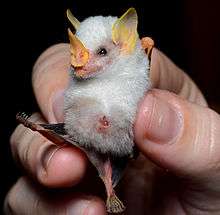Honduran white bat
| Honduran white bat | |
|---|---|
 | |
| Honduran white bat Ectophylla alba | |
| Scientific classification | |
| Kingdom: | Animalia |
| Phylum: | Chordata |
| Class: | Mammalia |
| Order: | Chiroptera |
| Family: | Phyllostomatidae |
| Genus: | Ectophylla H. Allen, 1892 |
| Species: | E. alba |
| Binomial name | |
| Ectophylla alba (H. Allen, 1892) | |
The Honduran white bat (Ectophylla alba) is a species of bat in the family Phyllostomatidae. The only member of the genus Ectophylla, it is found in Honduras, Nicaragua, Costa Rica and western Panama at elevations from sea level to 700 m.[1] It feeds at least in part on fruit.[1]
Habitat
The Honduran white bat cuts the side veins extending out from the midrib of the large leaves of the Heliconia plant causing them to fold down to form a 'tent'. They cling to the roof of this tent in small colonies of up to half a dozen individuals, consisting of one male and a harem of females. The tent protects them from rain and predators. Most tent-making bats (such as the aptly named tent-making bat) take flight at even slight disturbances, but researchers in Costa Rica have reported that Honduran white bats take flight only when the main stem of their tent is disturbed, possibly because they are well camouflaged. Although their tents are typically low to the ground (about six feet), sunlight filters through the leaf which gives their white fur a greenish cast. This almost completely conceals them if they remain still. It has been suggested a colony may have a number of tents scattered within the forest. It is one of 15 species of Latin American bats that roost in tents. In the Old World, 3 species of bat from India and Southeast Asia are known to roost in tents.
Physiology
The Honduran white bat (Ectophylla alba) is a bat that has – like its name suggests – snow white to grayish fur, along with an amber or yellow nose and ears. They are a near-threatened species of bat and are up for re-evaluation in the near future under the new standards of the IUCN. This bat, along with three Diclidurus are the only currently known species of bat where the pelage is all white. Most other bats species are a variant of brown, tan, or might have white markings in the case of the recently discovered Mindoro stripe-faced fruit bat. The bats are rather small in size, measuring at just 1–2 in (2.5–5.1 cm) in length and the weight is about up to 0.2 oz (6 g).
Behavior
It lives in Central America in dense thickets of the rainforests or abandoned banana fields (called groves). They are also known to roost inside abandoned buildings and hollow trees on occasion. They feed mostly on fruit, and they give birth in the spring to just one offspring.

Taxonomy
The Binomial Name of the Honduran White Bat is Ectophylla alba. Its genus is Ectophylla of which it may be the only member. Ectophylla belongs to the Subfamily Stenodermatinae of which many other bats are a part, such as the Red Fruit Bat, the Neotropical Fruit Bat, and many more (please note that these fruit bats are not in the same family as the Flying Foxes which are the large fruit bats that belong to the Suborder Megachiroptera). Stenodermatinae belongs to the family Phyllostomidae, which are also known as the leaf-nosed bats; well known members include all sorts of insectivores, frugivores, full-fledged vertebra eating predators, and the three species of bat which feed solely on the blood of other animals. Phyllostomidae belongs to the Superfamily Noctilionoidea, which contains the Fisherman Bats, Ghost-Faced bats, and short-tailed bats. Noctilionoidea belongs to the Suborder Microchiroptera, otherwise known as the microbats. Microchiroptera use echolocation to find their way about in the dark, they lack under-fur, and they feed primarily on insects – with the exceptions of the various families that feed on fruit, other animals, or blood. Microchiroptera belongs to the Order Chiroptera of which the Megabats are members (megabats lack echolocation with the exception of one single species, and feed primarily on fruit, they are also the largest bats alive). Chiroptera belongs to the Superorder Laurasiatheria of which we Homo sapiens sapiens are members, along with all the ungulates, carnivores, anteaters, and whales (and more). Laurasiatheria belongs to the Infraclass Eutheria, of which all placental mammals are members. Eutheria belongs to the Subclass Theria, of which the marsupials are members – but the monotremes are not, and this all belongs to the Class Mammalia.
References
- 1 2 3 Rodriguez, B. & Pineda, W. (2008). "Ectophylla alba". IUCN Red List of Threatened Species. Version 2010.2. International Union for Conservation of Nature. Retrieved 9 August 2010.
- ↑ Emmons, L.H (1997). Neotropical Rainforest Mammals. 2nd edition. ISBN 0-226-20719-6
- Timm, R. M.; Mortimer, J. (March 1976). "Selection of Roost Sites by Honduran White Bats, Ectophylla Alba (Chiroptera: Phyllostomatidae)". Ecology. Ecological Society of America. 57 (2): 385–389. JSTOR 1934829. doi:10.2307/1934829.
- Allen, H. (1892). "Ectophylla". Proc. U. S. Nat. Mus. 15: 441.
- Allen, H. (1892). "Ectophylla alba". Proc. U. S. Nat. Mus. 15: 442.
